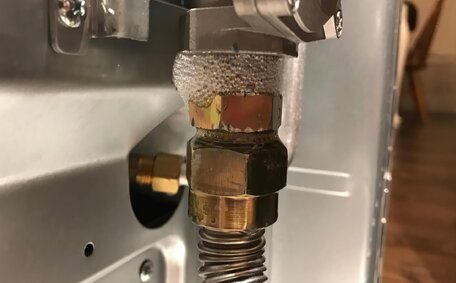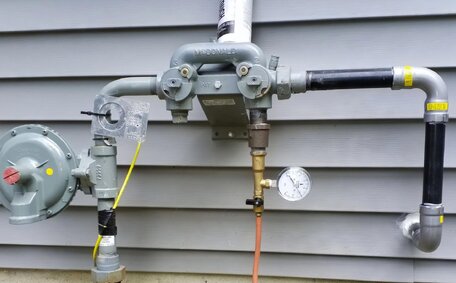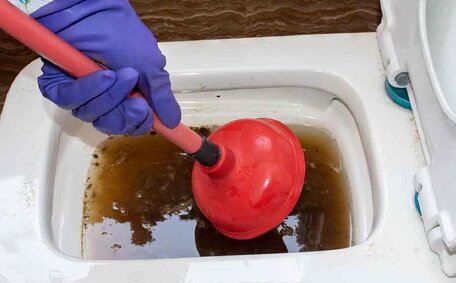Introduction To Gas Water Heater Pilot Lights
A gas water heater relies on a small, constantly-burning pilot light to ignite the burner when hot water is needed. This tiny flame is fueled by natural gas or LPG and provides a vital spark to heat the water in your tank.
Safely learning to relight pilot lights that have gone out is an important skill for any homeowner. While it may seem daunting, following some simple precautions and the correct procedure makes the process straightforward. We’ll provide clear, step-by-step instructions tailored to your specific water heater model to get your hot water flowing again.
If the pilot light repeatedly goes out, this indicates an underlying issue that requires further inspection by a professional. Our licenced plumbers have extensive experience troubleshooting tricky pilot light problems and getting water heaters firing properly.
Reasons Why A Pilot Light Goes Out
There are a few common reasons why a gas water heater’s pilot light can become extinguished:
- Strong drafts or gusts of wind blowing out the flame
- Dirt, dust or spider webs blocking the pilot light assembly
- A faulty thermocouple failing to keep the gas valve open
- Issues with the gas line feeding the water heater
- Moisture build-up putting out the flame
- The pilot light orifice becoming blocked or clogged
Drafts in utility rooms or garage spaces can gust through tiny cracks and extinguish the small pilot light flame. Over time, dust and debris can also accumulate on the pilot assembly, obstructing airflow.
A faulty thermocouple - the sensor that registers the pilot flame - may fail to deliver the electrical signal keeping the gas valve open.
Problems with the gas line like low pressure, a leak, or obsolete piping could also starve the pilot light of fuel. High humidity or condensation inside the tank may lead to moisture issues dousing the flame. Lastly, residue, oxidation, or insects building nests could clog the pilot orifice restricting gas flow.
If the pilot light continually blows out without explanation, contact our team to inspect for underlying faults. Our expertise isolating tricky water heater issues gets systems firing reliably again.
Safety Precautions
When relighting a water heater pilot light, safety should always be the top priority. There are a few key precautions to take:
- Scan the area around the water heater for any source of ignition such as cigarettes, flames or sparking tools. Ensure the space is free of ignition hazards.
- Stand near an exterior door for ventilation in case of gas leaks.
- Do a 'sniff test’ around the whole unit to check for gas odours before lighting.
- Review the manufacturer’s instructions for your specific model before attempting.
- Wear safety glasses to protect your eyes.
- Light long fireplace matches or a long-nozzled lighter to keep hands and fingers away from the flames and hot surfaces when igniting.
- Work slowly and cautiously. There is no need to rush the process.
- If you have any uncertainty about safely performing the steps, call a professional for assistance.
Taking a few minutes to guarantee your environment is secure makes relighting a pilot light a safe, worry-free process for DIY-savvy homeowners. Our team is always standing by if you need any help getting your hot water going again.
Tools Needed
Relighting a gas water heater pilot light requires just a few basic tools:
- Long fireplace matches or a long-reach lighter
- Adjustable wrench
- Flathead and Phillips head screwdrivers
- Needle nose pliers
- Flashlight
- Safety glasses
- Manufacturer’s instructions
The matches or lighter will be essential to light pilot flames once the gas is flowing. An adjustable wrench offers grip for loosening or tightening gas fittings if required. You may need screwdrivers to open an access panel to reach the pilot light assembly.
Needle nose pliers help grip the thermocouple tip if detachment from the pilot assembly is required. A flashlight illuminates the darkened spaces around water heaters. Don’t forget safety glasses to protect eyes.
Always have the manufacturer’s instructions specific to your unit on hand as well in case they recommend additional specialised tools. For electronic ignition water heaters, you often only need the manufacturer’s guide and a means of ignition during the relighting process.
Equipping yourself with this basic toolkit ensures you have everything necessary to get your pilot light reignited and hot water flowing in no time. Let us know if you need assistance gathering any specialty tools before starting the relight procedure.
Instructions For Relighting
Follow these step-by-step instructions to safely relight your water heater’s pilot light:
- Locate the access panel and manufacturer’s lighting instructions for your specific model.
- Turn the gas control valve to ‘pilot’ or the off position depending on your water heater type.
- Remove the access panel so you can reach the gas control valve and view the pilot light assembly.
- Make sure there are no sources of ignition nearby and sniff around the unit to check for gas leaks.
- Optional step: If your water heater has a reset button, press this down until you hear a click.
- Light your long match or lighter. Push down and hold the gas control reset button or turn the valve to pilot.
- Ignite the pilot flame and keep holding the gas control reset down for 30 seconds (for electronic ignition) or continue holding the pilot position on a manual gas valve.
- Check that the pilot light stays lit after releasing the gas control reset button or manual gas valve pilot position. If not, repeat steps 6 and 7.
- Turn the gas control knob to the on position or press the igniter button again until the burner ignites if you have an electronic ignition water heater.
- Reattach the access panel once the pilot remains lit and the main burner ignites.
- Allow 30 minutes for the tank to heat up and check for leaks during this time by smell and soap bubbles.
- Contact a licenced plumber immediately if you detect any gas smells before or after relighting.
Troubleshooting Issues
Even when carefully following all proper relighting steps, the pilot may encounter sporadic lighting problems. Here is some advice for troubleshooting common pilot light issues:
- If the pilot won’t stay lit after holding down the gas reset, strong drafts may be a factor. Close exterior doors/windows for 15 minutes, clear any obstructions around the unit then attempt relighting.
- A dirty or clogged pilot could be starving the flame. Use compressed air or a pipe cleaner to gently clear any debris blocking the tiny pilot opening.
- For electronic ignition heaters, check that a small indicator light is glowing and listen for the igniter clicking. If not, the circuit board may be faulty and require replacement.
- Check around the thermocouple tip - if covered in residue, use an emery cloth or steel wool to expose shiny metal for a clean connection.
- For repeated pilot outages, inspect the gas line valve for flaws preventing adequate fuel flow and contact a professional.
Our licenced technicians are fully equipped to accurately diagnose tricky pilot lighting problems. We can assess your system, identify any underlying issues and implement reliable solutions to get hot water running smoothly again.
When To Call A Professional
In most cases, homeowners can safely relight a water heater pilot light on their own when armed with the proper tools and manufacturer’s instructions. However, seeking professional assistance is wise in certain situations.
Contact a licenced plumber right away if:
- You smell gas anywhere around the unit before, during or after the relighting procedure.
- The pilot light repeatedly goes out after following all troubleshooting steps.
- You cannot keep the flame lit despite several careful attempts.
- Any other safety concerns arise about potential gas leaks or carbon monoxide risks.
For older units, we recommend inspection after 10 years to identify and remedy any risks associated with potential heat exchanger cracks or combustion vent blockages.
Seeking professional help can give homeowners peace of mind knowing any problematic underlying conditions will get properly diagnosed and fixed. Our team at Kenthurst Plumbing has extensive experience servicing all major hot water system brands and models.
For prompt and reliable assistance relighting tricky water heater pilot lights, contact our friendly staff. Call 1300 349 338 or email [email protected]. As a licenced, insured and experienced plumbing business serving Sydney for over 10 years, we guarantee effective solutions for restored hot water comfort.
Conclusion and Next Steps
Understanding how relight a gas water heater’s pilot light is a straightforward process for most DIY-savvy homeowners when equipped with the proper tools and manufacturer’s instructions. We hope this guide has equipped you with clear, step-by-step directions to get your hot water flowing again quickly and safely.
Carefully work through each relighting step, taking all necessary safety precautions. Refer back to the troubleshooting tips if the pilot encounters sporadic lighting issues. Remember to call our team at Kenthurst Plumbing anytime gas odours arise or the pilot won’t stay lit after several attempts.
For additional assistance getting your water heater reignited or questions about maintenance, don’t hesitate to get in touch. Call 1300 349 338 or email [email protected] to book an appointment with our licenced technicians. We service all major hot water system brands and guarantee effective solutions for restored comfort and safety.






